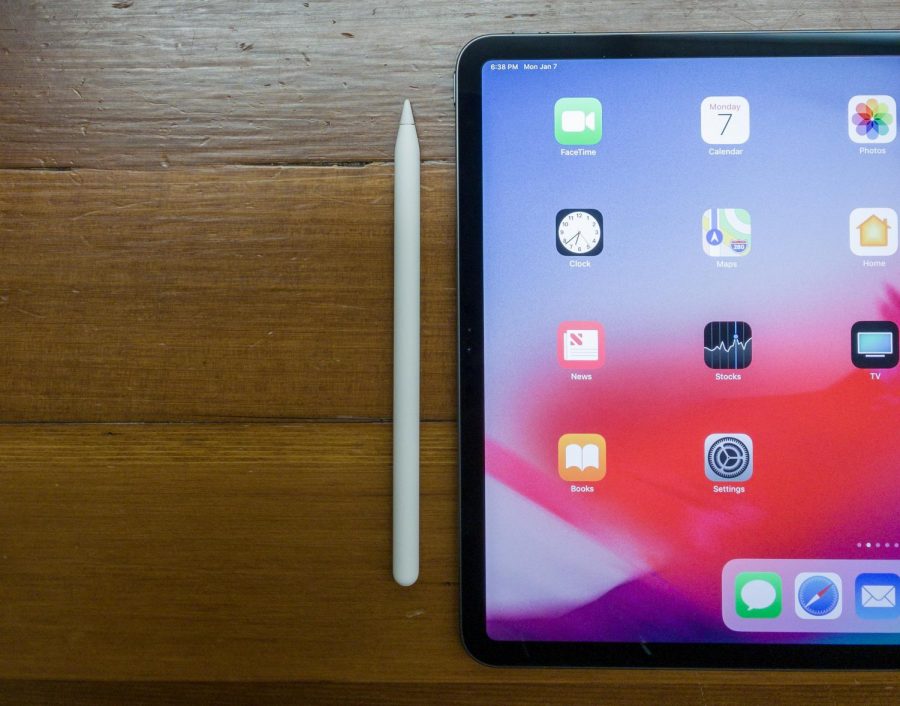The 2018 iPad Pro Is the Beginning of the Future for Education Technology
The redesigned 2018 iPad Pro and second generation Apple Pencil are advancements in technology that will further education technology.
January 9, 2019
Last fall, along with the iPhone XS, iPhone XR, Mac mini, and MacBook Air, Apple also released an all-new iPad Pro, Apple Pencil with wireless charging, and a fully redesigned Smart Folio Keyboard for the iPad. These new products are a big advancement for technology, and are clearly pointing to where technology is headed in the near future. While all of these new products are designed extremely well, one that specifically stands out is the iPad Pro.
With an overall 4.5-star rating on Amazon, the 2018 iPad Pro features an all-screen design, almost identical to the iPhone XS and XR, which were released earlier. Apple has removed the headphone jack, as well as the home button, and created a gesture-based experience modeled after iOS 12 on the iPhone X, XR, and XS.
While the gesture-based navigation of the iPad is well done and is easy to adapt to, on a device such as the iPad, it would have been nice to keep a headphone jack, as this makes it much easier to connect to larger or older sound systems without using an adapter.
In terms of upgraded technology, the 2018 iPad Pro features the Apple A12X Bionic chip, embedded M12 coprocessor, and a neural engine for AI capabilities, as well as Face ID. The iPad Pro also features a 12 megapixel camera with aperture as low as f/1.8, a five-element sapphire crystal lens, up to 63 megapixel panorama photos, and many software improvements such as portrait mode, improved HDR, exposure control, and photo geotagging. This puts it in the same category as the iPhone XR in terms of photography, and makes it appealing to a much larger variety of people.
While the improved camera is a great improvement, the size of the device makes it difficult to use in most settings, especially in crowded areas where holding up a big tablet to take a photo could easily annoy the people around you. However, the improvements for the rare occasion where the camera is needed on the iPad will not go unnoticed.
One of the most notable improvements to the 2018 model is the implementation of USB-C. Unlike the previous Lightning connector, USB-C offers many new capabilities for the iPad such as connecting an external display, faster data transfer, universal connectivity with almost all modern devices without an adapter, and the ability to charge your iPhone directly from the USB port on the iPad. One of the other major benefits of using USB-C on the iPad is how common it is on new electronics. Most new computers come with at least one USB-C port, and many smartphones, tablets, and cameras have replaced aging Micro USB ports with USB-C, making it a common and convenient port on new electronics.
Over the last few years, Apple has moved towards advertising the iPad as an equal or better alternative to a laptop or desktop, instead of a tablet working along with a computer.
At a special event on Oct. 30, 2018, the company announced that a full desktop version of Adobe Photoshop, a popular photo editing application, would be available in early 2019. As a longtime user of Photoshop, I find this addition to the iPad to be a great addition.
Currently, most professional applications available on the iPad are scaled down versions of their desktop counterparts, and offer less features, but companies like Adobe have committed to bringing true desktop applications to the iPad in the near future. This opens up many more opportunities for the iPad to be used in classrooms.
The iPad also features many upgrades that are useful in both education and business applications. Regarding its new features, Apple claims that the iPad is “like a computer, [but] unlike any computer.” The new features almost guarantee a shift from laptops and desktops in the education industry, and we are already seeing this transition in business.
Various software updates to built-in applications such as Notes and Mail make it a perfect candidate for education, and third party options such as Notability integrate nicely with the second generation of the Apple Pencil.
The Apple Pencil is now lighter and has the ability to charge when magnetically attached to the side of the iPad, instead of charging via the Lightning port. I have been using the first generation Apple Pencil for several years, and I am very excited to see a new charging solution for it.
Similar to the first generation Apple Pencil, the second version can also determine the way you are holding it, and can sense the amount of pressure being applied to the display via the Pencil, making it a great option for taking handwritten notes, drawing, or working on projects.
However, these new-and-improved technologies do not come without a cost, at least for the education market. The baseline iPad Pro starts at $799, plus an additional $280 for the Apple Pencil and Smart Folio case, compared to Google’s Chromebook, which can be found new for as little as $179. Because the new iPad is completely redesigned, neither the first generation Apple Pencil or Smart Keyboard case are compatible with it.
While this new technology is a huge step, the iPad has become a larger investment for government-funded school districts as well as privately funded institutions, making it a less accessible option for many students across the country. Many government-funded school districts are running on tight budgets, and it is difficult to justify the high cost for this type of technology.
Though it comes with a hefty price tag, in today’s technology-centered world, the iPad Pro makes much more sense for the education industry compared to traditional laptops. With its lighter and more versatile design, ease of use, and advanced features compared to previous models, it fits into schools and universities seamlessly.
Correction: January 10, 2019
An earlier version of this story misstated the starting price of the iPad Pro. The starting price is $799, not $699.






Cyrus Kelly Jr • Jan 15, 2019 at 2:20 pm
This article is well written. It also makes a few suggestions that lead me to believe a copy should be forwarded to the appropriate Apple Business Department. Reilly makes some good arguments for his suggestions and may be well received by Apple.